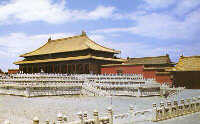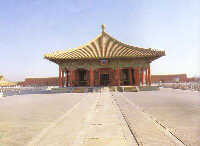Taihedian (Hall of Supreme Harmony)

Entering Taihemen, you will see Taihedian (Hall of Supreme Harmony) across the spacious square, which covers a space of 30,000 square meters. Sitting on a three-tier marble terrace, the grandest timber framework ever in China will overwhelm anyone.
The hall was first built in 1406 and later repaired many times. As the heart of the Forbidden City, the so-called Golden Carriage Palace, used to be the place where emperors received high officials and practiced their rule over the nation. Also grand ceremonies would be held to celebrate new emperor's ascending to the throne, emperors' birthdays and wedding ceremonies and other important occasions such as Winter Solstice, the Chinese New Year and dispatching generals into war fields.
Along the three-tier terrace stairs, there are 18 bronzeDings, a kind of ancient Chinese vessel, to represent 18 provinces of the nation then. On the terrace, which was luxuriously balustraded, a bronze crane and a bronze tortoise can be seen. They were put there to expect everlasting rule and longevity. The marbleRigui, an ancient timer in the east and theJialiang, an ancient measuring vessel in the west were put there to show that emperors were just and fair. In front of the hall, there are a couple of gilded bronze vats, which were used to hold water in case of fire.
Since the Hall of Supreme Harmony was the symbol of imperial power, it was the highest structure in the Ming and Qing dynasties in the nation, no other buildings allowed higher than it. The heavily glazed hall is 35.02 meters high and 37.44 if rooftop decoration counted, and 63.96 meters in width and 37.2 meters in length respectively. There are totally 72 pillars standing in six rows to support the roof. Gates and windows were embossed with clouds and dragons.
Inside of the hall, the floor was paved with special bricks which were fired long and then soaked in tung oil to be polished. As a symbol of imperial power, the sandalwood throne, standing on a two-meter high platform, is located in the center of the hall and enclosed within six thick gold-lacquered pillars painted with dragons. The golden throne is carved with dragons all over. Around the throne stand two bronze cranes, an elephant-shaped incense burner and tripods in the shape of mythical beasts. The hall is heavily painted with dragons, having an aura of solemnity and mystery. In the middle of the ceiling is the design of two dragons playing with pearls. They were made of glass and painted with mercury. The pearl was said to be able to detect any usurper of the imperial power. If anyone who was not the descendant of the Emperor Huang Di usurped the throne, it would drop down and strike him to death.
Zhonghedian (Hall of Central Harmony)

Zhonghedian, the Hall of Central Harmony, was originally built in 1420 and restored in 1627 and again 1765. It is square in shape rather than rectangular as the other two in the Outer Court. It is the smallest in the three main halls in the Outer Court. It served as a restroom when emperors were going to present ceremonies held in the Hall of Supreme Harmony on their way there. Here they would interview their ministers of rite. Annually before their departure to important sacrifice rites held at Temple of Heaven, Temple of Earth and etc., emperors would browse elegiac addresses in the hall. Before their departure to the Temple of Ancestor Farmer, they would also inspect seeds and farming tools they would use in the ceremony. In the Qing Dynasty, it was prescribed that the imperial genealogy should be revised every ten years. The ceremony of presenting the revision to the emperor and His Majesty's approving would also be held here.
Inside of the hall, visitors can see there is one golden unicorn on each side of the throne in the center of the hall. The couple of golden unicorns, calledluduanin Chinese, were believed capable of traveling 9,000 kilometers a day and speaking many languages. Since the divine beast foresees faraway, it was put beside the throne to indicate emperors' wisdom and brilliantness. They used to be sandalwood burners. Beside the throne, there are also two sedan chairs, which were used as emperors' vehicles to shuttle around in the Forbidden City.










